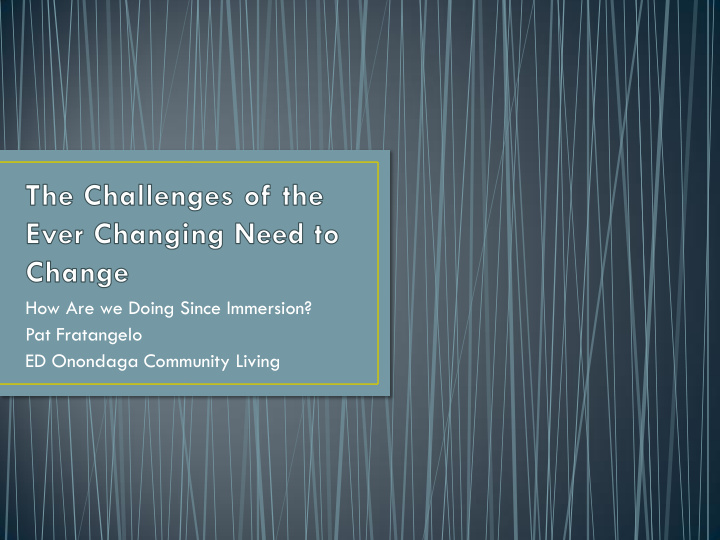



How Are we Doing Since Immersion? Pat Fratangelo ED Onondaga Community Living
• We are inevitably creatures of habit and, even in the service of others, return again and again to our own convenience. Our needs and values are no less important than those of others, so the harm comes in not in having these. Rather, we must be alert to whether the hungers of or own “personhood” somehow distort or diminish the identity of others Michael Kendrick Smits p 85 One Person at a Time
• Of People • Of Systems • Of Organizations
Capacity Performance Effectiveness _______ __________ ___________ Means Measurement of Impact on goals and constituents/society What is high objectives achieving in start Deviates of society up years often are Goals for the or included in considered program or goals society? underachievement for the person? In later years
• I think of myself as a bus driver. My job is to pick people up on the corner where they stand and take them where they need to go. Br. Michael McErnery, F.L.C
• Phase One: Creativity • Too many organizations focus on creating new programs instead of building organizational capacity • Listening, exploring, not presuming • Phase Two: Direction • Communications changes, power of control goes more to people supported, supporters and families.
Phase Three: Delegation Those closest to people are given greater responsibility, top management role changes, the pyramid reverses Phase Four: Coordination Formalized systems are developed to capture the implementation of new services and organizational success in providing them Phase Five: Collaboration Flexible and behavioral approach to organizational management, rather than red taped. Collaborative team work with emphasis on fixing problems as they come up.
• A set of assumptions that human (an organizational development) is marked by critical juncture and milestones that result in qualitative changes in capacities and characteristic behaviors in each phase of life.
• A stage is a developmental period when characteristic patterns of behavior are evidenced and certain capacities become established • Developmental changes occur in distinct stages over qualitative patterns • It assumes that each stage is increasingly complex while integrating, to some extent the changes and accomplishments of earlier stages .
• People are where they are. To help them means meeting them right there – not where you wish they were, where they should be, nor where they tell you they are – but rather, right where they are • Gisela Konopka
• Organizations that master multiple challenges of the growth stage will eventually become mature • Many stall out because the challenges are greater than they have the capacity to handle. • Until maturity is achieved, a variety of structural problems or growing pains will distract the work from the mission.
• Growing pains are a natural part or organizational evolution • They can frequently become stalling points and account for why an organization never meets maturity • Maturity is when the organization is well established, operating smoothly, made the new transition and has a community reputation for providing consistent and high quality services.
• Pat Fratangelo • Onondaga Community Living • 518 James St. Suite 110 • Syracuse, New York 13203 USA • patfrat@oclinc.org • 1-315-434-9597 call extension 203
Recommend
More recommend